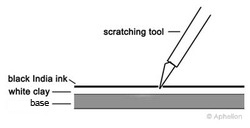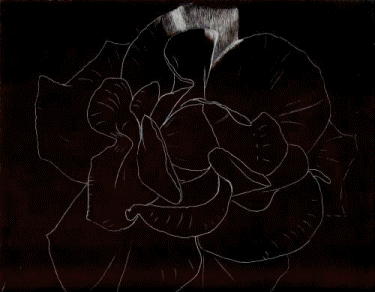What is Scratchboard?

The scratchboard technique is a two-dimensional subtractive process. It involves the use of abrasive tools to directly remove a surface layer of one value (typically dark) to expose a second layer (typically white). The values within the artwork are predominantly achieved by varying the amount of surface layer that has been scratched away or left. The texture and form of all key compositional elements within the artwork must be created by subtractive removal, not exclusively by the addition of paint or ink. Reapplying transparent mediums over the scratching is permissible, but the underlying scratches must remain visible. Works may be color or black and white.
If color is being added, a variety of transparent mediums may be used, including watercolor, ink, and fluid acrylics. A white scratchboard can also be covered initially with other colored media, and then scratched.
Many artists use sharp tools such as scalpel blades to scratch into the clay, creating work with exceptional detail and realism, but any abrasive implement may be used to create a variety of effects. This unique process has attracted artists for its control in rendering intricate subject matter, while remaining highly versatile to those exploring folk art, abstract work and many other artistic styles.
Scratchboard has roots going back to the 1800’s when black and while illustrations were created for newspapers and books. Creation of archival, museum grade materials has allowed it to continually evolve to the present day where it is now prominent in design work and fine art.
by Lorna Hannett, MSA
The textures and contours of the rose petals are created by scratching away the black. Lighter sections are achieved by more scratching in select areas. After the scratching is completed, color is added. After the color dries, additional scratching creates highlights. Color can be added to the highlights, and so on, until the piece is complete.
